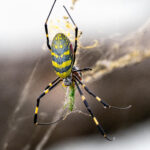Fruit flies, scientifically known as Drosophila melanogaster, are tiny insects that play a giant role in the world of genetics and biological research. These seemingly simple creatures have been instrumental in countless scientific breakthroughs, and understanding their genetic makeup, particularly their chromosomes, is fundamental to appreciating their significance. So, how many chromosomes do fruit flies actually have? The answer is that fruit flies have 8 chromosomes in their diploid cells, arranged as 4 pairs. This relatively small number of chromosomes, combined with other advantageous characteristics, makes them an incredibly valuable model organism for scientists worldwide.
To understand the number of chromosomes in fruit flies, it’s helpful to first grasp what chromosomes are and their function. Chromosomes are thread-like structures located in the nucleus of animal and plant cells. They are made of DNA and protein, carrying genetic information in the form of genes. Genes determine our traits, from eye color to susceptibility to certain diseases. Organisms inherit half of their chromosomes from each parent.
Fruit flies, like humans and many other animals, are diploid organisms. This means they have two sets of chromosomes – one set inherited from each parent. In the case of Drosophila melanogaster, their diploid number (represented as 2n) is 8. This means a typical fruit fly cell contains 8 chromosomes, organized into 4 homologous pairs. Conversely, their haploid number (n), found in their gametes (sperm and egg cells), is 4. This means each gamete carries 4 chromosomes. When fertilization occurs, the sperm and egg fuse, restoring the diploid number of 8 chromosomes in the offspring.
[Image: Illustration of fruit fly chromosomes, showing 4 pairs, labeled with numbers or descriptions. Alt text: Fruit fly chromosomes diagram showing four pairs of homologous chromosomes, illustrating the diploid number of 8.]
Among these four pairs of chromosomes, three are autosomes, which are non-sex chromosomes, and one pair is the sex chromosomes. Fruit flies, like mammals, have a system of sex determination based on chromosomes. Females have two X chromosomes (XX), while males have one X chromosome and one Y chromosome (XY). Therefore, the sex chromosomes determine the sex of the fruit fly.
The relatively small number of chromosomes in fruit flies is just one of the reasons they are such powerful model organisms. Their simple genetics, short life cycle, ease of breeding in the lab, and the availability of a fully sequenced genome have made them invaluable tools for studying a wide array of biological processes, including:
- Inheritance and Genetics: Fruit flies were central to early genetics research, particularly the work of Thomas Hunt Morgan, which elucidated the role of chromosomes in heredity.
- Developmental Biology: Scientists study fruit flies to understand how a single fertilized egg develops into a complex organism.
- Evolutionary Biology: Their rapid reproduction rate allows researchers to observe evolutionary changes over relatively short periods.
- Disease Modeling: Fruit flies are used to model various human diseases, including neurodegenerative disorders and cancer, allowing for the testing of potential therapies.
[Image: Microscopic image of fruit fly chromosomes during cell division. Alt text: Microscopic view of fruit fly chromosomes during metaphase of mitosis, highlighting chromosome structure.]
In conclusion, fruit flies possess 8 chromosomes, arranged in 4 pairs in their diploid cells. This simple yet well-defined genetic structure, along with their other advantageous characteristics, has cemented their position as a cornerstone of biological research. Understanding the number and organization of fruit fly chromosomes is key to appreciating their contribution to our understanding of genetics, development, and disease. From basic principles of inheritance to complex genetic interactions, Drosophila melanogaster continues to provide invaluable insights into the fundamental mechanisms of life.
